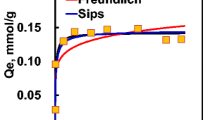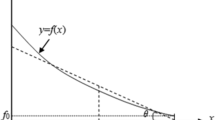Abstract
Metal removal kinetics and metal ion selectivity in ion flotation were studied from a thermodynamic perspective. Surface tension data could be used with the Gibbs adsorption equation to quantitatively predict the metal-ion removal kinetics in alkylsulfate-Cu systems. However, surface tensions predicted cation selectivity coefficients in the sodium dodecylsulfate (SDS)-Cu-Ca and SDS-Cu-Pb systems rather poorly, although the predicted order of the selectivity (Cu2+ < Ca2+ < Pb2+) was correct. Another thermodynamic selectivity model, which used the Grahame adsorption equation and a geometrical analysis, predicted cation selectivity coefficients that agreed very well with experimentally measured values.
Similar content being viewed by others
References
Clarke, A.N., and Wilson, D.J., 1983, Foam Flotation: Theory and Applications, Marcel Dekker, New York.
Dean, J.A., 1978, Lange’s Handbook of Chemistry, 12th edition, McGraw-Hill Inc.
Doyle F.M., Duyvesteyn, S., and Sreenivasarao, K., 1995, “The use of ion flotation for detoxification of metal-contaminated waters and process effluents” Proceedings of XIX International Mineral Processing Congress, Vol. 4, SME, Littleton, CO, pp. 175–179.
Duyvesteyn, S., 1994, “Removal of Trace Metal Ions from Dilute Solutions by Ion Flotation: Cadium-Dodecylsulfate and Copper-Dodecylsulfate Systems,” Master Thesis, University of California, Berkeley.
Grieves, R.B., and Kyle, R.N., 1982, “Models for interactions between ionic surfactants and nonsurface-active ions in foam fractionation processes,” Separation Science and Technology, Vol. 17(3), pp. 465–483.
Grieves, R.B., Burton, K.E., and Craigmyle, J.A., 1987, “Experimental foam fractionation selectivity coefficients for the alkali (Group IA) metals,” Separation Science and Technology, Vol. 22, No. 6, pp. 1597–1608.
Huang, R.C.H., and Talbot, F.D., 1973, “The removal of copper, cadmium and lead ions from dilute aqueous solutions using foam fractionation,” Canadian Journal of Chemical Engineering, Vol. 51, pp. 709–713.
Huang, S., Ho, H., Li, Y., and Lin, C., 1995, “Adsorbing colloid flotation of heavy metal ions from aqueous solutions at large ionic strength,” Environmental Science and Technology, Vol. 29, pp. 1802–1807.
James, R.O., and Healy, T.W., 1972, “Adsorption of hydrolyzable metal ions at the oxide-water interface III. A thermodynamic model of adsorption,” Journal of Colloid and Interface Science, Vol. 40, No. 1, July, pp. 65–81.
Jorne, J., and Rubin, E., 1969, “Ion fractionation by foam,” Separation Science, Vol. 4, No. 4, August, pp. 313–324.
Liu. Z., and Doyle, F.M., 2001a, “A thermodynamic approach to ion flotation. I. Kinetics of cupric ion flotation with alkylsulfates,” Colloids and Surfaces, A: Physicochemical and Engineering Aspects, Vol. 78, pp.79–92.
Liu, Z., and Doyle, F.M., 2001b, “A thermodynamic approach to ion flotation. II. Metal ion selectivity in the SDS-Cu-Ca and SDS-Cu-Pb Systems,” Colloids and Surfaces, Vol. 178, pp. 93–103.
Morgan, J.D., Napper, D.H., Warr, G.G., and Nicol, S.K., 1992, “Kinetics of recovery of hexadecyltrimethyl-ammonium bromide by flotation,” Langmuir, Vol.8, pp. 2124–2129.
Morgan, J.D., Napper, D.H., Warr, G.G., and Nicol, S.K., 1994, “Measurement of the selective adsorption of ions at air/surfactant solution interfaces,” Langmuir, Vol. 10, pp. 797–801.
Morgan, J.D., Napper, D.H., and Warr, G.G., 1995, “Thermodynamics of ion exchange selectivity,” Journal of Physical Chemistry, Vol. 99, pp. 9458–9465.
Okamoto, Y., and Chou, E.J., 1976, “Chelation effects of surfactant in foam separation: Removal of cadmium and copper ions from aqueous solution,” Separation Science, Vol. 11, No. 1, pp. 79–87.
Pinfold, T.A., 1972, “Ion flotation,” Adsorptive Bubble Separation Techniques, R. Lemlich, ed., Academic Press.
Sebba, F., 1959, Nature, Vol. 184, p. 1062.
Sreenivasarao, K., 1996, “Removal of Toxic Metals from Dilute Synthetic Solutions by Ion and Precipitate Flotation,” Ph.D. dissertation, University of California, Berkeley.
Sreenivasarao, K., Doyle, F.M., and Fuerstenau, D.W., 1993, “Removal of toxic metals from dilute effluents by ion flotation,” EPD Congress’93, J.P. Hager, ed. TMS, Warrendale, PA, pp. 45–56.
Valdes-Krieg, E., et al., 1977, “Separation of cations by foam and bubble fractionation,” Separation and Purification Methods, Vol. 6, No. 2, pp. 221–285.
Walkowiak, W., 1991, “Mechanism of selective ion flotation. 1. Selective flotation of transitional metal cations,” Separation Science and Technology, Vol. 26, No. 4, pp. 559–568.
Author information
Authors and Affiliations
Rights and permissions
About this article
Cite this article
Liu, Z., Doyle, F.M. Modeling metal ion removal in alkylsulfate ion flotation systems. Mining, Metallurgy & Exploration 18, 167–171 (2001). https://doi.org/10.1007/BF03402891
Accepted:
Published:
Issue Date:
DOI: https://doi.org/10.1007/BF03402891




